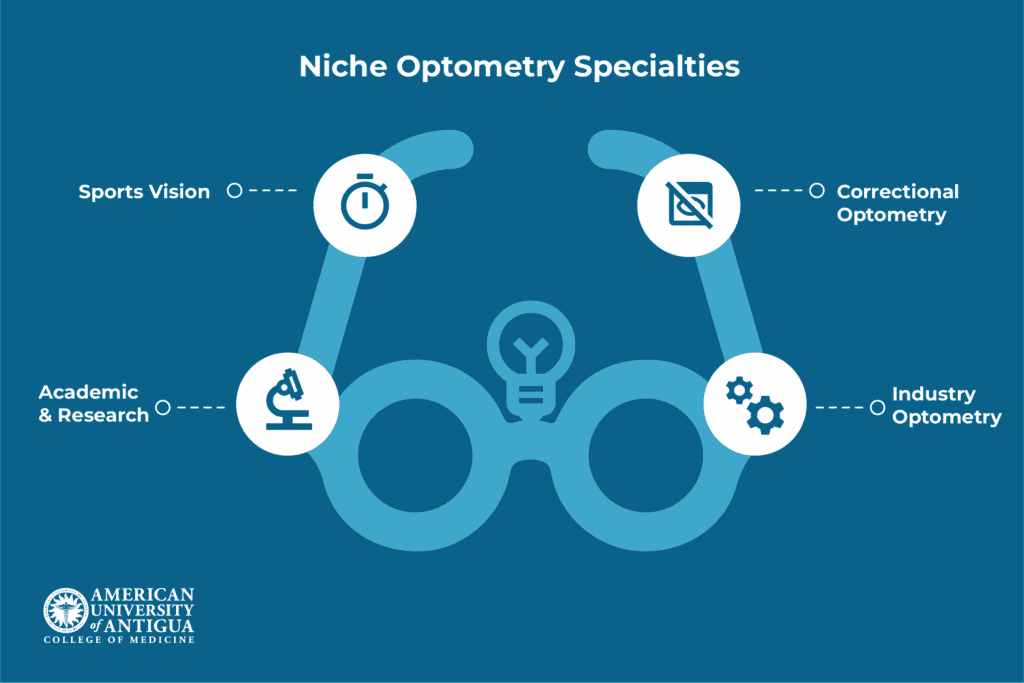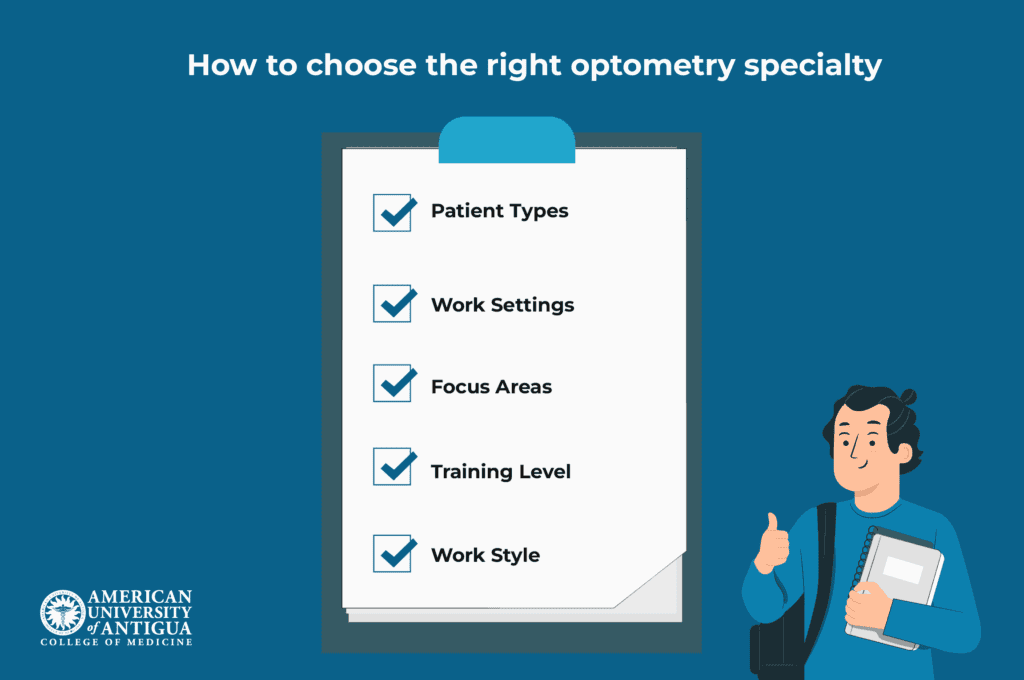Top Optometry Specialties and Career Paths
Key Takeaways
- Optometry is a rapidly expanding field that offers a wide range of career opportunities, from treating severe eye conditions to assisting children with their eye health.
- Specialties such as geriatric optometry, low vision care, and pediatric optometry focus on specific populations and their unique requirements for eye care.
- As the field continues to evolve, emerging subspecialties such as sports vision, correctional optometry, and optometry research are gaining popularity.
- When choosing an optometry specialty, it’s important to consider the type of patients you want to work with, your preferred work environment, the complexity of care involved, and any additional training required.
Optometry is an exciting healthcare profession that focuses on taking care of your vision and eye health, from routine eye exams to the treatment of severe conditions. As the field continues to grow, optometry offers many specialties and career paths. Advancements in technology, increased awareness of eye health, and a rising demand for specialized care have made it more dynamic and diverse than ever.
Whether working with children, managing chronic eye diseases, or conducting research, optometrists have many opportunities to shape fulfilling careers in specialized areas. In this article, we’ll explore some of the top optometry specialties, giving you an idea of what each involves and how they can shape your future career.
✅ Request information on AUA's MD program TODAY!
YOUR PATH TO SUCCESS BEGINS HERE
Most Common Optometry Specialties
Optometry offers a wide range of specialties that allow eye doctors to focus on specific types of patients and conditions. Some of the most common include working with children (pediatric optometry), supporting older adults (geriatric optometry), caring for individuals with significant vision loss (low vision care), fitting contact lenses, and managing eye diseases.
These specialties enable optometrists to provide the best care for different patient needs. Each specialty requires unique skills and knowledge to address specific conditions, making optometry a highly diverse and dynamic field.
Pediatric optometry
Pediatric optometry is a specialized branch dedicated to the eye health and vision development of infants, children, and teenagers. This specialty serves patients from birth through their late teens. Pediatric optometrists diagnose and manage common childhood vision issues like lazy eye (amblyopia), crossed eyes (strabismus), nearsightedness, farsightedness, and eye coordination difficulties.
They also address vision-related learning difficulties and ensure a child’s visual system is developing properly to support academic and everyday activities. Early intervention is key in this field, as it can prevent long-term vision problems and promote healthy visual development.
Low vision rehabilitation
Low vision rehabilitation is a specialty that helps people with permanent vision loss that cannot be fully corrected with glasses, contact lenses, or surgery. While it serves patients of all ages, many are older adults.
Specialists in this field work with conditions like macular degeneration, glaucoma, diabetic retinopathy, or inherited eye diseases. They help patients make the most of their remaining vision using magnifiers, special lighting, and visual training. This specialty can significantly improve the patient’s quality of life by teaching them how to adapt and maintain independence despite limited vision.
Neuro-optometry
Neuro-optometry deals with vision problems caused by injuries or disorders of the brain and nervous system. Patients of all ages may need neuro-optometric care, especially after experiencing strokes, traumatic brain injuries, or neurological conditions such as multiple sclerosis.
Optometrists in this specialty address issues like double vision, difficulty focusing, eye movement disorders, and visual field loss. They often collaborate with neurologists and rehabilitation teams to support the patient’s overall recovery. Neuro-optometry is particularly important for improving the quality of life and helping individuals regain functional vision following neurological events.
Contact lens specialist
Contact lens specialists focus on fitting and managing contact lenses for patients with both routine and complex vision needs. They work with individuals of all ages, including teens and adults, who prefer contact lenses over glasses. This specialty also serves patients with conditions like keratoconus, dry eye syndrome, or corneal irregularities that make standard lenses uncomfortable or ineffective.
Optometrists in this specialty use a variety of lens types, including soft lenses, rigid gas-permeable lenses, and specialty lenses designed for medical purposes. By offering customized solutions, contact lens specialists help patients achieve clearer vision and greater comfort in their day-to-day lives.
Ocular disease optometry
Ocular disease optometry involves diagnosing and managing diseases that affect the eyes. While these optometrists primarily treat adult and elderly patients, certain eye conditions can also impact younger individuals. Common diseases they manage include glaucoma, cataracts, macular degeneration, diabetic eye diseases, and eye infections.
Ocular disease optometrists often collaborate with ophthalmologists and use advanced imaging and diagnostic tests to monitor eye health and prevent vision loss. This specialty plays a crucial role in detecting eye diseases early, preventing more serious complications such as blindness.
Geriatric optometry
Geriatric optometry specializes in caring for the eye health of older adults, typically those aged 60 and above. As people age, their risk for developing eye conditions increases, so geriatric optometrists focus on age-related issues like cataracts, glaucoma, macular degeneration, and dry eye syndrome. They also help seniors in managing vision changes that impact their independence, such as difficulties with reading or mobility.
Regular eye care from a geriatric optometrist is vital for maintaining quality of life in later years. As the aging population grows, this specialty is becoming increasingly important in promoting healthy aging and preventing vision loss.
Emerging and Niche Optometry Subspecialties
Emerging and niche optometry subspecialties focus on specific groups, unique work environments, or specialized areas of eye care. These roles go beyond standard eye exams and often require additional training or experience.
Some examples include sports vision optometry, which helps athletes improve their visual skills for better performance; correctional optometry, which provides eye care within prisons; academic and research optometry, where optometrists teach or conduct vision-related research; and industry optometry, where they collaborate with companies on new eye care products and technology. We’ll talk more about each of these specialties in the following sections.

Sports vision optometry
Sports vision optometry focuses on enhancing visual skills that are important for athletic performance, such as hand-eye coordination, reaction time, depth perception, and tracking moving objects. This subspecialty serves athletes of all ages and skill levels, from young competitors to professionals.
With the increasing demand for personalized athletic training and performance optimization, sports vision optometry is rapidly growing and has become an invaluable tool for maximizing visual abilities.
Correctional optometry
Correctional optometry provides eye care services to individuals in correctional facilities – jails, prisons, and juvenile detention centers. This subspecialty addresses a population that often lacks regular access to healthcare and may suffer from untreated vision issues.
As healthcare access expands to underserved communities, including incarcerated individuals, the demand for correctional optometrists is on the rise. Eye care in correctional settings is gaining attention as an important aspect of supporting inmate health and rehabilitation.
Academic and research optometry
Academic and research optometry involves teaching future optometrists and conducting research on eye health, vision science, and new treatment methods. This subspecialty benefits students, fellow researchers, and the broader eye care community.
Academic and research optometry is growing due to the need for ongoing innovation and the training of the next generation of optometrists. Advances in vision science and technology are creating new opportunities for optometrists passionate about education and discovery.
Industry optometry
Industry optometry allows optometrists to work with companies in areas like product development, clinical trials, regulatory affairs, and professional education. These professionals help develop and test new vision care products, such as lenses, equipment, and eye drops.
Optometrists in this field serve businesses and, indirectly, the patients who benefit from improved products and technology. As the eye care market continues to grow, the need for optometrists in industry roles is becoming more important than ever.
How to Choose the Right Optometry Specialty

Choosing the right optometry specialty depends on your interests and the type of work that suits you best. A key factor is the type of patients you want to work with – some optometrists enjoy caring for children, while others prefer seniors, athletes, or individuals in unique settings like correctional facilities.
It’s also important to consider the kind of place you want to work in, whether that’s a clinic, university, company, or prison system.
Another consideration is whether you’re drawn to managing medical eye conditions or enhancing performance, like in sports vision. Some specialties may also require additional training or a residency, which can take more time and money.
Finally, think about how much you want to work directly with patients compared to doing research, teaching, or working in the business side of optometry. Taking all these factors into account can help you choose a specialty that aligns with your career aspirations, interests, and strengths.
Conclusion
Optometry offers a wide range of specialties, from well-established fields like pediatric and geriatric care to emerging areas like sports vision and correctional optometry. Choosing the right path depends on your aspirations and interests – the type of patients you want to help, the setting you want to work in, or your long-term career goals in clinical care, research, or the industry. It’s also important to consider the level of training required and how much direct patient interaction you prefer.
If you’re exploring career options in healthcare and want to see how medical education can shape your future, check out the American University of Antigua College of Medicine (AUACOM) to learn more about the opportunities they offer in the medical field.
Frequently Asked Questions
What is the difference between an optometrist and an ophthalmologist?
An optometrist provides primary eye care – vision tests, prescriptions for glasses or contact lenses, and the diagnosis and management of common eye conditions. Meanwhile, an ophthalmologist is a licensed medical doctor trained to perform eye surgery and treat more complex eye diseases.
Do optometrists need a residency to specialize?
While optometrists can pursue additional training or a residency to specialize, it’s not required for most specialties. However, certain advanced or highly focused areas of practice may recommend or prefer residency training.
✅ Request information on AUA's MD program TODAY!